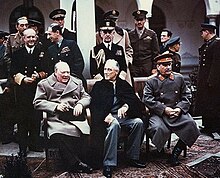Livadia
| Livadia | ||
| Ливадия / Лівадія | ||

|
|
|
| Basic data | ||
|---|---|---|
| Oblast : | Autonomous Republic of Crimea | |
| Rajon : | City of Yalta | |
| Height : | 141 m | |
| Area : | 174.9 km² | |
| Residents : | 1,618 (2016) | |
| Population density : | 9 inhabitants per km² | |
| Postcodes : | 298655, 298656 | |
| Area code : | +380 3654 | |
| Geographic location : | 44 ° 28 ' N , 34 ° 9' E | |
| KOATUU : | 0111947900 | |
| Administrative structure : | ||
| Statistical information | ||
|
|
||
Livadia ( Russian Ливадия , Ukrainian Лівадія , Crimean Livadiya ) is an urban-type settlement on the Crimean peninsula. In 2016, 1,618 people lived there. Here is a former palace of the tsars , where the Yalta Conference took place in 1945 .
geography
Livadija is located in the extreme south of the Crimea, 3 kilometers southeast of the city of Yalta .
Surname
The name Livadia probably derives from the ancient Greek entrance to Paradise from
history
Until the 17th century
From the 3rd millennium BC Tombs are known as the first traces of settlement in the area of the present-day location. Excavations showed that a settlement with a church existed there in the 8th to 10th centuries. Until the 12th century a feudal could at this location on the Hachla-Kajasy rock fortress be detected. In the 17th century the Greek settlement Aj-Jan ( = Saint John ) dominated the area.
1778 to 1918
When it was relocated to the Azov government in 1778 on the orders of Tsar Paul I , some Crimean Tatars stayed here. In 1835 the small Tatar settlement on this site was renamed Livadija . During this time, a mansion with a spacious park and courtyards was built in the village by the Polish nobleman Lew Potocki . In 1859 there were 30 farms on Liwadija, where a total of 140 people lived.
In 1861 the mansion was converted into the summer residence of the Russian Tsar Alexander II and the imperial family and in the following years. Tsar Alexander III died in the Livadija Palace in 1894. His son Nikolai II had the White Palace built in 1909 , which has been preserved to this day.
Since 1918
From 1931 to 1941 a sanatorium for farmers was operated in the palace complex . From 1941 to 1944, Liwadija was occupied by the German Wehrmacht during World War II . After the capture of Sevastopol and thus the entire Crimea by the 11th German Army , the central ceremony at the end of the Crimean campaign took place in the palace garden of Liwadija on July 6, 1942, at which the commanding General Erich von Manstein was appointed General Field Marshal .
In 1944 the place was recaptured by the Red Army.
From February 4 to 11, 1945, the Yalta Conference took place in the Liwadija Palace , at which the leaders of the USA ( Franklin D. Roosevelt ), Great Britain ( Winston Churchill ) and the host Soviet Union ( Josef Stalin ) negotiated on post-war Europe.
The main inner belt asteroid (3006) Livadia is named after Liwadija.
Attractions
- Summer residence of the tsars with a museum
The White Palace was in 1910 and 1911 by order of Tsar Nicholas II in early. Italian Renaissance - style built around a courtyard in a Moorish style, instead of a palace from the 18th century. Special surface-treated white limestones from Inkerman were used as building material . The building contained 116 rooms in different styles. The Livadija Palace became the tsar's favorite residence.
In 1974, on the occasion of an official state visit by US President Nixon, a contemporary history museum was set up in the main wing . The ground floor is dedicated to the Yalta conference, where the rooms are still set up exactly as they were at the time of the conference. The upper floor was reopened in 1992 with the original tsar's apartments. The study and the chambers of the imperial family can be visited.
Web links
Individual evidence
- ↑ Новые телефонные коды городов Крыма . Крымтелеком. Archived from the original on May 6, 2016. Retrieved July 24, 2016.
- ↑ Erich von Manstein: Lost victories. 16th ed. Bonn, 2000. pp. 283-285.
- ^ Lutz D. Schmadel : Dictionary of Minor Planet Names . Fifth Revised and Enlarged Edition. Ed .: Lutz D. Schmadel. 5th edition. Springer Verlag , Berlin , Heidelberg 2003, ISBN 978-3-540-29925-7 , pp. 186 (English, 992 pp., Link.springer.com [ONLINE; accessed October 2, 2019] Original title: Dictionary of Minor Planet Names . First edition: Springer Verlag, Berlin, Heidelberg 1992): “1979 SF 11 . Discovered 1979 Sept. 24 by NS Chernykh at Nauchnyj. "




